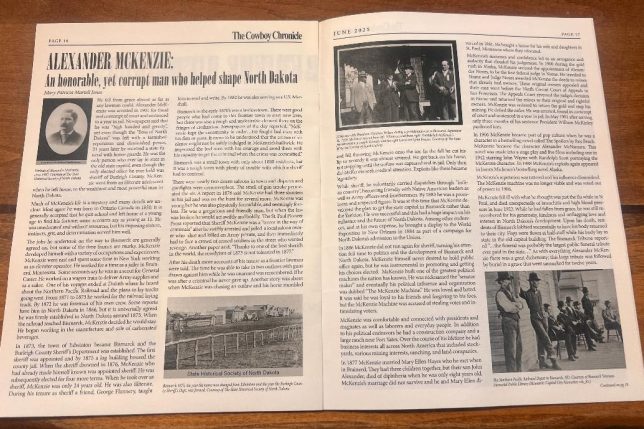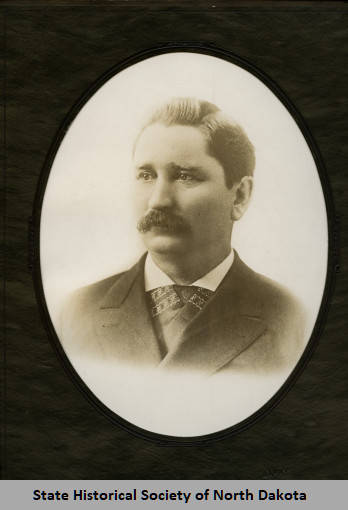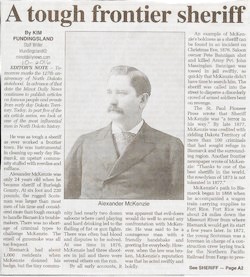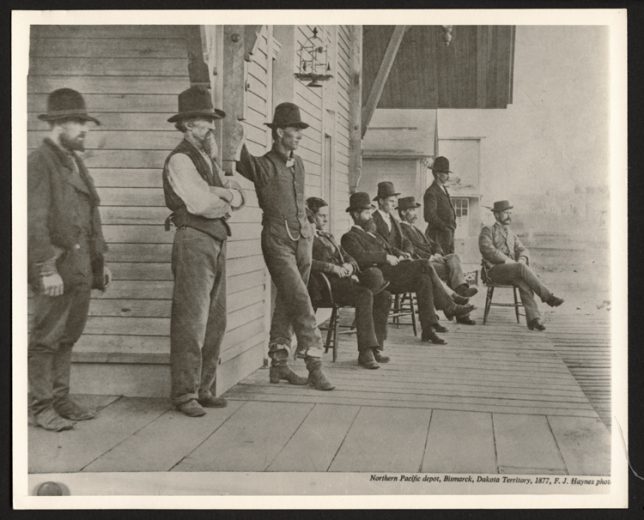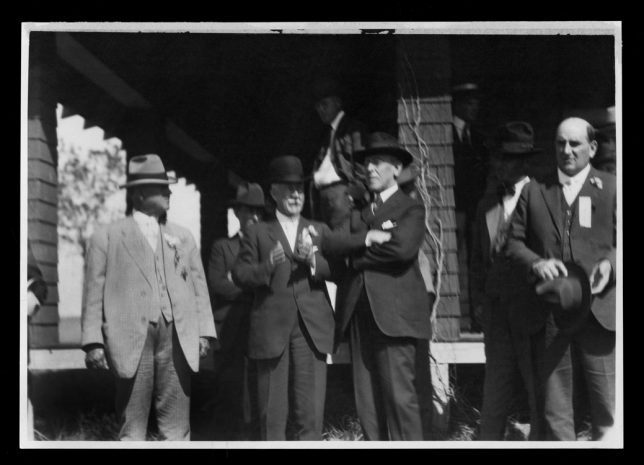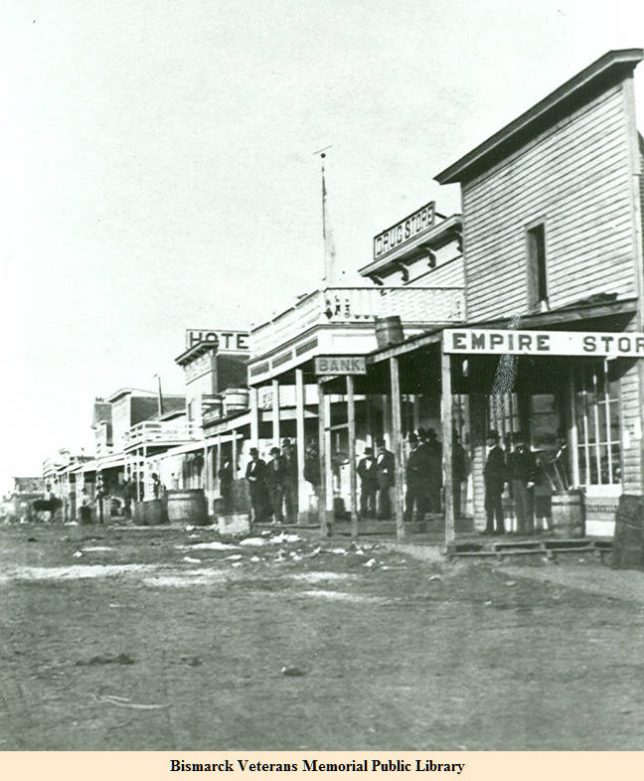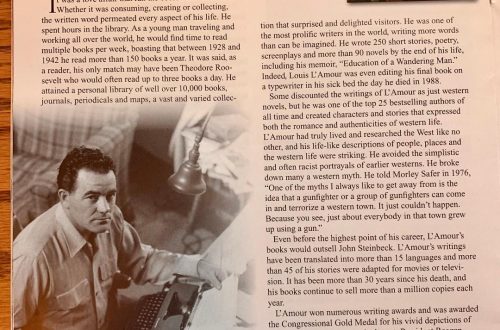Alexander McKenzie: An honorable, yet corrupt man who helped shape North Dakota
This is the first in a series of stories in the Cowboy Chronicle about pioneer lawmen and law enforcement
He fell from grace almost as far as any lawman could. Alexander McKenzie was arrested in 1901 for fraud and contempt of court and sentenced to a year in jail. Newspapers said that he was “high handed and greedy”, yet even though the “Boss of North Dakota” was left with a tarnished reputation and diminished power, 21 years later he received a state funeral with honor guards. He was the only person who ever lay in state in the old state capitol, even though the only elected office he ever held was sheriff of Burleigh County. McKenzie went from an illiterate adolescent when he left home, to the wealthiest and most powerful man in North Dakota.
Much of McKenzie’s life is a mystery and many details are unclear. Most agree he was born in Ontario Canada in 1850. It is generally accepted that he quit school and left home at a young age to find his fortune; some accounts say as young as 11. He was uneducated and without resources, but his imposing stature, instincts, grit, and determination served him well.
The jobs he undertook on the way to Bismarck are generally agreed on, but some of the time frames are murky. McKenzie developed himself with a variety of occupations and experiences. McKenzie went east and spent some time in New York working as an elevator operator. He worked for a time as a jailer in Brainerd, Minnesota. Some accounts say he was as a scout for General Custer. He worked on a wagon train to deliver Army supplies and as a sailor. One of his voyages ended at Duluth where he heard about the Northern Pacific Railroad and the plans to lay tracks going west. From 1871 to 1873 he worked for the railroad laying track. By 1872 he was foreman of his own crew. Some reports have him in North Dakota in 1866, but it is universally agreed he was firmly established in North Dakota around 1873. When the railroad reached Bismarck, McKenzie decided he would stay. He began working in the manufacture and sale of carbonated beverages.
In 1873, the town of Edwinton became Bismarck and the Burleigh County Sheriff’s Department was established. The first sheriff was appointed and by 1875 a log building housed the county jail. When the sheriff drowned in 1876, McKenzie who had already made himself known was appointed sheriff. He was subsequently elected for four more terms. When he took over as sheriff, McKenzie was only 24 years old. He was also illiterate. During his tenure as sheriff a friend, George Flannery, taught him to read and write. By 1882 he was also serving as a U.S. Marshall.
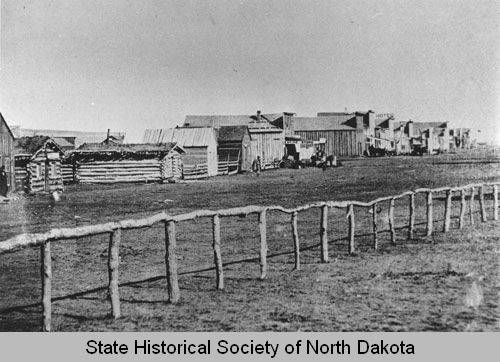
the Burleigh County Sheriff’s Dept. was formed.
Bismarck in the early 1870’s was a lawless town. There were good people who had come to this frontier town to start new lives, but there was also a rough and undesirable element there on the fringes of civilization. Newspapers of the day reported, “McKenzie kept the community in order…He fought bad men with his fists or guns. It came to be understood that the crimes of violence might not be safely indulged in McKenzie’s bailiwick. He impressed the bad men with his courage and awed them with his capacity to get the criminal when the crime was committed.”
Bismarck was a small town with only about 1000 residents, but it was a tough town with plenty of trouble with which a sheriff had to contend. There were nearly two dozen saloons in town and disputes and gunfights were commonplace. The smell of gun smoke permeated the air. A report in 1876 said McKenzie had three shooters in his jail and was on the hunt for several more. McKenzie was young but he was also physically formidable, and seemingly fearless. He was a gregarious and friendly man, but when the law was broken he would act swiftly and boldly. The St. Paul Pioneer Press reported that Sheriff McKenzie was a “terror in the way of criminals” after he swiftly arrested and jailed a local saloon owner who shot and killed an Army private, and then immediately had to face a crowd of armed soldiers in the street who wanted revenge. Another paper said, “Thanks to one of the best sheriffs in the world, the rowdyism of 1873 is not tolerated in 1877.”
After his death more accounts of his tenure as a frontier lawman were told. The time he was able to take in two outlaws with guns drawn against him while he was unarmed was remembered. If he was after a criminal he never gave up. Another story was about when McKenzie was chasing an outlaw and his horse stumbled and fell throwing McKenzie onto the ice. In the fall he cut his lip so severely it was almost severed. He got back on his horse, not stopping until the outlaw was captured and in jail. Only then did McKenzie seek medical attention. Exploits like these became legendary.
While sheriff, he voluntarily carried dispatches through “Indian country”, becoming friendly with Native American leaders as well as Army officers and frontiersmen. By 1883 he was a prominent and respected figure. It was at this time that McKenzie developed the plan to get the state capitol in Bismarck rather than the Yankton. He was successful and this had a huge impact on his influence and the future of North Dakota. Among other endeavors, and at his own expense, he brought a display to the World Exposition in New Orleans in 1884 as part of a campaign for North Dakota’s admission to the Union.
In 1886 McKenzie did not run again for sheriff, turning his attention full time to politics and the development of Bismarck and North Dakota. McKenzie himself never desired to hold public office again, but he was instrumental in promoting and getting his choices elected. McKenzie built one of the greatest political machines the nation has known. He was nicknamed the “senator maker” and eventually his political influence and organization was dubbed “The McKenzie Machine.” He was loved and hated. It was said he was loyal to his friends and forgiving to his foes, but the McKenzie Machine was accused of stealing votes and intimidating voters.
McKenzie was comfortable and connected with presidents and magnates as well as laborers and everyday people. In addition to his political endeavors he had a construction company and a large ranch near Fort Yates. Over the course of his lifetime he had business interests all across North America that included stockyards, various mining interests, ranching, and land companies.
In 1877 McKenzie married Mary Ellen Hayes who he met when in Brainerd. They had three children together, but their son John Alexander, died of diphtheria when he was only eight years old. McKenzie’s marriage did not survive and he and Mary Ellen divorced in 1881. He bought a house for his wife and daughters in St. Paul, Minnesota where they relocated.
McKenzie’s successes and confidence led to an arrogance and audacity that clouded his judgement. In 1900 during the gold rush in Alaska, McKenzie secured the appointment of Alexander Noyes, to be the first federal judge in Nome. He traveled to Nome and Judge Noyes awarded McKenzie the deeds to mines that already had owners. These original owners appealed and their case went before the Ninth Circuit Court of Appeals in San Francisco. The Appeals Court reversed the judge’s decision in Nome and returned the mines to their original and rightful owners. McKenzie was ordered to return the gold and stop his mining. He defied the order. He was arrested, found in contempt of court and sentenced to a year in jail. In May 1901 after serving only three months of his sentence President William McKinley pardoned him.
In 1906 McKenzie became part of pop culture when he was a character in a bestselling novel called The Spoilers by Rex Beach. McKenzie became the character Alexander McNamara. This novel was made into a stage play and five films including one in 1942 starring John Wayne with Randolph Scott portraying the McKenzie character. In 1988 McKenzie’s exploits again appeared in James Michener’s bestselling novel Alaska.
McKenzie’s reputation was tattered and his influence diminished. The McKenzie machine was no longer viable and was voted out of power in 1906.
McKenzie fell ill with what he thought was just the flu while in St Paul, and died unexpectedly of bronchitis and high blood pressure in June 1922. While he had fallen from grace, he was still remembered for his generosity, kindness and unflagging love and interest in North Dakota’s development. Upon his death, residents of Bismarck lobbied successfully to have his body returned to their city. Flags were flown at half-staff while his body lay in state in the old capitol building. The Bismarck Tribune reported “…the funeral was probably the largest public funeral tribute ever paid in the state…” As with everything Alexander McKenzie there was a great dichotomy; this large tribute was followed by burial in a grave that went unmarked for twelve years.
After his death a second family came forward that no one knew, even his closest friends. McKenzie had married Elva Stewart a Bismarck schoolteacher around 1890. McKenzie and Elva had three children, a daughter and two sons. After their first child was born in 1893, McKenzie established a home for his new family in New York City. This marriage and family was not known until probate was filed and his will was opened. He bequeathed portions of his estate to all his living children and Elva who had died just a month earlier, as well as his old friend George Flannery.
Alexander McKenzie was an enigma, a complicated and fascinating man. He was honorable and corrupt. He was a true frontier lawman. His contributions to the development of North Dakota should not be understated. He is mostly remembered today for his political influence, but his time as a lawman early in his adult life was instrumental in Bismarck’s history and McKenzie’s personal development. Upon his death many tributes were written. A Bismarck Tribune editorial concluded, “He was a unique figure in the history of the state and he will be missed by the people of the state of North Dakota, for whatever Alexander McKenzie was, North Dakota had a friend and her people a worthy champion.”
Resources:
https://www.history.nd.gov/archives/manuscripts/inventory/11100.html
Newspapers.com, The Bismarck Tribune, Sunday June 19, 1925, Alexander McKenzie Dominated Dakota Destiny 50 Years
Newspapers.com, The Ward County Independent,Thursday June 29, 1922, Alex. McKenzie, Best Known North Dakota Politician Died in St Paul; Ill 2 Days
https://www.newspapers.com/image/55702084/?match=1&terms=bismarck tribune alexander McKenzie
https://www.newspapers.com/image/55702020/?match=1&terms=Alexander McKenzie Bismarck Tribune
https://prabook.com/web/alexander.mckenzie/2563528
https://news.prairiepublic.org/show/dakota-datebook-archive/2022-05-26/alexander-mckenzie
https://www.minotdailynews.com/news/local-news/2016/11/a-tough-frontier-sheriff/
https://ca.pbslearningmedia.org/resource/alexander-mckenzie-video/prairie-mosaics-shorts/
https://www.findagrave.com/memorial/59195706/alexander_john-mckenzie
Pictures Courtesy of the State Historical Society of North Dakota and Bismarck Veteran’s Memorial Public Library, Bismarck, ND
